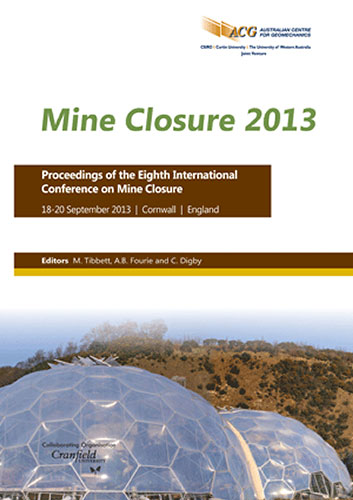Mine closure – misplaced planning priorities

|
Authors: Limpitlaw, D; Mitchell, P |
DOI https://doi.org/10.36487/ACG_rep/1352_01_Limpitlaw
Cite As:
Limpitlaw, D & Mitchell, P 2013, 'Mine closure – misplaced planning priorities', in M Tibbett, AB Fourie & C Digby (eds), Mine Closure 2013: Proceedings of the Eighth International Seminar on Mine Closure, Australian Centre for Geomechanics, Cornwall, pp. 3-13, https://doi.org/10.36487/ACG_rep/1352_01_Limpitlaw
Abstract:
Mines, unlike many other industrial activities, pass through distinct life-cycle phases from exploration and prefeasibility through operations to closure and rehabilitation. Closure assumptions have become an integral part of the planning for closure process. Good practice requires closure planning for each life cycle phase, with a growing focus on planning from the very earliest stages of project development. Each phase is characterised by specialist groups of people – starting with optimistic exploration geologists, focussed project managers for the construction phase and systems-orientated mining and process engineers for the operational phase. All of these have some deliberate or unintentional role to play in planning for closure. However, the training and mind-sets of each of these groups, and the reliability of the assumptions they are using as they play their part in the closure planning process, have significant implications. Exploration imperatives for rapid orebody delineation and land access may result in inadvertent impacts with long-term implications for final closure. These include providing community access to previously inaccessible natural resources, the early introduction of invasive exotic species and ‘going off-message’ relative to what a trained social scientist or closure specialist might say. During construction, high magnitude social impacts associated with the influx of large numbers of construction workers may be overlooked due to their transient nature, and many mid-life mines fail to adequately manage key closure resources, like topsoil, because closure is seen as an event in the distant future. To further complicate matters, unplanned, sudden closure may occur at any time over the mine’s life: many sites only expect to close after years of operation, and closure at some other point in the life cycle may bring with it a number of unforeseen challenges. Communities and other stakeholders in mining operations also change their expectations of closure planning as the mine matures. Initially, many stakeholders struggle to come to terms with the high failure rate of exploration projects and local entrepreneurs may overextend themselves in the expectation of economic expansion accompanying mine development. Later, communities may become unwittingly dependent on services that are only sustainable while the mine is in operation (like a cellular phone tower in a rural area) and may mistake closure planning and consultation for opportunities to increase their dependence on the mine (by requesting additional employment or infrastructure development, for example). Examples drawn largely from the authors’ experiences in southern and central Africa are used to illustrate these misplaced planning priorities and the related consequences. The paper concludes with suggestions for improving closure planning efficacy across the mining life cycle and optimising inputs from the many disciplines involved directly and indirectly in the process.
References:
Absolom, S.S. and Limpitlaw, D. (2005) Revisiting closure: environmental restoration for sustainable land utilisation at Zwartkop chrome mine, in Proceedings The Future of Mining Environmental Management in the Context of South African Legislative
Developments, a Colloquium, 21 July 2005, South African Institute of Mining and Metallurgy, Johannesburg, 14 p.
Digby Wells (2010) Notification and Updated Background Information Document for Resource Generation’s Boikarabelo Coal Mine Projects, Digby Wells and Associates, 9 p.
EPA (Environmental Protection Agency) (2011) Guidelines for Preparing Mine Closure Plans, Department of Mines and Petroleum, Government of Western Australia, 78 p.
Hoadley, E.M. and Limpitlaw, D. (2004) Coping with the Lifecycle of Extractive Industries, unpublished research report for the Centre for Development and Enterprise, 48 p.
ICMM (International Council on Mining and Metals) (2008) Planning for Integrated Mine Closure: Toolkit, London, 86 p.
IFC (International Finance Corporation) (2002) It’s Not Over When It’s Over: Mine Closure Around the World, World Bank and IFC, Washington, 19 p.
Koma, S.B. (2012) The evolution of developmental local government in South Africa: issues, trends and options, Journal of US-China Public Administartion, Vol. 9(1), pp 53–67.
Ministry for Provincial and Constitutional Development (1998) White Paper on Local Government, Pretoria, South Africa.
Newman, H.R. (2010) The minerals industry of Sweden, USGS 2010 Minerals Yearbook Sweden (advance release), viewed 20 June 2013, .
Pallett, J. (1995) The Sperrgebiet: Namibia’s Least Known Wilderness – An Environmental Profile of the Sperrgebiet or Diamond Area 1 in South-Western Namibia, DRFN and NAMDEB, Windhoek, Namibia, 84 p.
Peck, P., Blakau, F., Bogdanovic, J., Sevaldsen, P., Skaalvik, J.F., Simonett, O., Thorsen, T.A., Kadyrzhanova, I., Svedberg, P. and Daussa, R. (2005) Mining for Closure: Policies and Guidelines for Sustainable Mining Practice and Closure of Mines, UNEP, UNDP, OSCE and NATO, 97 p.
Sternlund, H. (2008) Ny gruvepok invigs, Svappavaara: Norrländska Socialdemokratern, viewed 20 June 2013, .
Sternlund, P. (2009) En annan tid ett annat KIRUNA, I love Kiruna (in Swedish): 94–97, viewed 20 June 2013, .
© Copyright 2025, Australian Centre for Geomechanics (ACG), The University of Western Australia. All rights reserved.
View copyright/legal information
Please direct any queries or error reports to repository-acg@uwa.edu.au
View copyright/legal information
Please direct any queries or error reports to repository-acg@uwa.edu.au